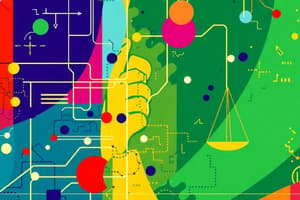Podcast
Questions and Answers
Which of the following are types of computer users? (Select all that apply)
Which of the following are types of computer users? (Select all that apply)
- Personal Computer User (correct)
- Power User (correct)
- Mobile User (correct)
- Super User (correct)
- None of the above
What does SSD stand for?
What does SSD stand for?
- Super-Speed Drive
- Solid-State Disk (correct)
- Single Storage Device
- Solid-State Drive (correct)
True or False: A biometric input device can identify users based on their physical characteristics.
True or False: A biometric input device can identify users based on their physical characteristics.
True (A)
What is the primary purpose of document management software?
What is the primary purpose of document management software?
An _____ is used to connect a computer to a projector or monitor for displaying video and audio.
An _____ is used to connect a computer to a projector or monitor for displaying video and audio.
Which of the following terms refers to software that is available for free but typically requires payment for additional features?
Which of the following terms refers to software that is available for free but typically requires payment for additional features?
What is the main risk associated with using flawed software?
What is the main risk associated with using flawed software?
What is the function of OCR?
What is the function of OCR?
True or False: Open Source Software is software with publicly available source code.
True or False: Open Source Software is software with publicly available source code.
The process of keeping data secure by making copies is known as _____
The process of keeping data secure by making copies is known as _____
Flashcards are hidden until you start studying
Study Notes
System Technology
- Covers the foundational aspects of computing, including hardware and software.
- Highlights how technology has evolved to include various applications and user categories.
Hardware
- Encompasses physical components of a computer system such as processors, memory, and storage devices.
- Important hardware includes Solid-State Drives (SSD), memory card readers, and multi-touch screens.
Software
- Refers to programs and operating systems that instruct hardware on how to perform tasks.
- Categories include freeware, shareware, open-source software, proprietary software, and document management software.
Types of Computer Users
- Personal Computer Users: Regular end users for tasks like gaming, browsing, and social media.
- Small Office Home Office (SOHO) Users: Individuals working from home or in small business settings.
- Super Users/Power Users: Highly skilled individuals who use advanced software and hardware functionalities.
- Mobile Users: Users who rely on portable devices for computing tasks.
Solid-State Drive (SSD)
- A storage device that uses flash memory to offer faster read and write speeds compared to traditional hard drives.
Memory Card Reader
- A device used for reading and writing data to various types of memory cards typically used in cameras and mobile devices.
Multi-Touch Screen
- An interface allowing multiple points of touch, enhancing user interactivity and engagement.
HDMI (High-Definition Multimedia Interface)
- A standard for transmitting high-definition video and audio from a device to a display.
3D Printing/Printers
- Technology that creates three-dimensional objects from digital files, used in various industries from manufacturing to healthcare.
Storage
- Refers to options for saving data, including HDDs, SSDs, and other storage solutions.
Biometric Input
- Implements unique physical traits, such as fingerprints or iris scans, for identification and security.
Interactive Whiteboards
- Digital boards that allow users to interact using touch or special tools, popular in educational settings.
Convergence
- The integration of various technologies into a unified system, creating smarter devices and applications.
Resolution and Image Quality
- Key factors in imaging technology that determine the clarity and detail of visual output.
USB, Plug and Play
- USB (Universal Serial Bus) is a standard interface for connecting peripherals; Plug and Play technology allows automatic recognition and configuration of devices.
Licensing and Licensing Agreements
- Includes terms under which software can be used, such as end-user license agreements, site licenses, and Creative Commons licenses.
Software Problems/Issues
- Common challenges range from software bugs to compatibility problems, highlighting the importance of software updates and patches.
Voice Recognition
- Also known as speech recognition, it enables computers to understand and process human speech, enhancing user interface applications.
Web Browsers
- Software applications for accessing information on the internet, offering tools for navigation and interaction with web content.
Web-Based Applications vs. Installed Applications
- Web-based applications operate through the internet, while installed applications reside on a user's local device, providing different functionalities and access methods.
Studying That Suits You
Use AI to generate personalized quizzes and flashcards to suit your learning preferences.




